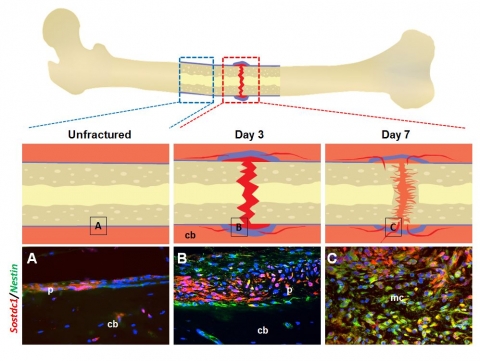Fracture healing involves communications between bone, muscle, vasculature, and the periosteum temporarily and spatially during fracture repair. Specifically, the periosteum, the thin fibrous tissue covering the cortical bone contains stem cells that migrates to the fracture site and differentiate into chondrocytes (cartilage forming cells) and/or osteoblasts (bone forming cells). However, little is known about the interaction of stem cells within the periosteum with the bone cells during fracture healing.

Sostdc1 marks a population of osteochondral progenitor cells. (A) Sostdc1-positive cells reside in the periosteum (red cells) of intact bones. At 3 days post-fracture (B), the periosteum thickens and the population of Sostdc1 positive cells expands (red cells). (C) These Sostdc1 positive cells migrate into the callus and co-express mesenchymal stem cell (MSCs) marker nestin (yellow).
A collaboration between Dr. Gabriela Loots’ lab at Lawrence Livermore National Laboratory (LLNL) and Dr. Jennifer Manilay at the University of California, Merced identified Sostdc1, a paralog of Sclerostin (Sost), as a regulator of mesenchymal stem cells quiescence in the periosteum, during fracture repair. ‘This study showed that Sostdc1 knockout mice, despite exhibiting a lower trabecular bone phenotype; they had larger, denser, bone cortices which when fractured, healed at an accelerated rate than wildtype counterparts’ states Cristal Yee, a UC Merced Quantitative and Systems Biology graduate student mentored by Dr. Loots in the School of Natural Sciences, and 2nd author of the study. Furthermore, the team was able to show that Sostdc1 expression marks a population of stem cells that rapidly expands and invades the fracture callus to contribute to the repair process. These findings suggests that Sostdc1 has an important role during stem cell self-renewal and differentiation, which may be advantageous in understanding how stem cells within the periosteum are involved in fracture healing and in developing novel therapeutics for difficult to heal fractures.
The team also included LLNL scientists Nicole Collette, Nicholas Hum and Deepa Murugesh, UC Davis scientist Blaine Christiansen, Indiana University professor Alexander Robling as well as Drs. Liqin Xie and Aris Economides of Regeneron.
The study was featured online in the journal Bone on April 19, 2016 http://www.sciencedirect.com/

